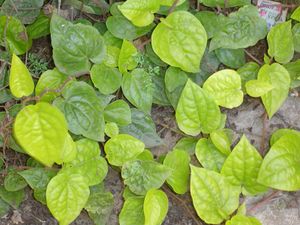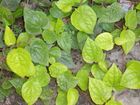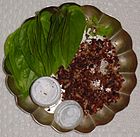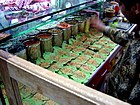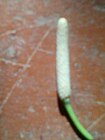Note: This is a project under development. The articles on this wiki are just being initiated and broadly incomplete. You can Help creating new pages.
Difference between revisions of "Piper betle - Nagavallari"
m (Jayashree moved page Betel to Nagavallari) |
|||
| (19 intermediate revisions by 4 users not shown) | |||
| Line 1: | Line 1: | ||
[[File:Piper betle plant.jpg|thumb|right|''betel leaf'', ''Piper betle'', ''Nagavallari'']] | [[File:Piper betle plant.jpg|thumb|right|''betel leaf'', ''Piper betle'', ''Nagavallari'']] | ||
| + | '''Piper betle''' is eulogized by ayurveda acharyas for their immense medicinal properties. Piper betle is a vine which belongs to Piperacea family. This vine has heart shaped leaves and is mostly grown in South East Asia. | ||
| + | ==Uses== | ||
| + | {{Uses|Wounds}}, {{Uses|Joint pains}}, {{Uses|Stomach colicky}}, {{Uses|Indigestion}}, {{Uses|Bad breath}}, {{Uses|Weight loss}}, {{Uses|Erectile disfunction}}, {{Uses|Diarrhea}}, {{Uses|Sore throats}}. | ||
| − | + | ==Parts Used== | |
| + | {{Parts Used|Vines}}, {{Parts Used|Leaves}}, {{Parts Used|Roots}}, {{Parts Used|Fruits}}. | ||
| − | + | ==Chemical Composition== | |
| + | Leaf contains Water (85-90%), Proteins (3-3.5%), Carbohydrates (0.5-6.1%), Minerals (2.3-3.3%), Fat (0.4-1%), Fibre (2.3%), Essential oil (0.08-0.2%), Tannin (0.1-1.3%), Alkaloid. <ref name="chemical composition"/> | ||
| − | + | ==Common names== | |
| + | {{Common names|kn=Veelyade Ele|ml=|sa=|ta=Vettilai|te=Tamalapaku|hi=|en=Betel pepper}} | ||
| + | |||
| + | ==Properties== | ||
| + | Reference: Dravya - Substance, Rasa - Taste, Guna - Qualities, Veerya - Potency, Vipaka - Post-digesion effect, Karma - Pharmacological activity, Prabhava - Therepeutics. | ||
| + | ===Dravya=== | ||
| + | |||
| + | ===Rasa=== | ||
| + | Tikta (Bitter), Kashaya (Astringent) | ||
| + | ===Guna=== | ||
| + | Laghu (Light), Ruksha (Dry), Tikshna (Sharp) | ||
| + | ===Veerya=== | ||
| + | Ushna (Hot) | ||
| + | ===Vipaka=== | ||
| + | Katu (Pungent) | ||
| + | ===Karma=== | ||
| + | Kapha, Vata | ||
| + | ===Prabhava=== | ||
| + | |||
| + | ==Habit== | ||
| + | {{Habit|Evergreen climbing shrub }} | ||
| + | |||
| + | ==Identification== | ||
| + | ===Leaf=== | ||
| + | {{Leaf|Simple|Ovate-oblong|Those at apex of stem sometimes elliptic, 7-15 × 5-11 cm}}<ref name="Leaf"/> | ||
| + | |||
| + | ===Flower=== | ||
| + | {{Flower|Unisexual|2-4cm long|Yellow|2|Flowers Season is May-Jul}} | ||
| + | |||
| + | ===Fruit=== | ||
| + | {{Fruit|General|7–10 mm|Clearly grooved lengthwise, Lowest hooked hairs aligned towards crown||Many}} | ||
| + | |||
| + | ===Other features=== | ||
| + | |||
| + | ==List of Ayurvedic medicine in which the herb is used== | ||
| + | * [[Nagavallabha rasa]] | ||
| + | * [[Brihat Vishama Jwarantak lauh]] | ||
| + | <ref name="Ayurvedic preparations"/> | ||
| + | |||
| + | ==Where to get the saplings== | ||
| + | ==Mode of Propagation== | ||
| + | {{Propagation|Cuttings}}. | ||
| + | |||
| + | ==How to plant/cultivate== | ||
| + | Cuttings 30 - 45cm long, taken from the tips of vertical shoots.<ref name="How to plant/cultivate"/> | ||
| + | |||
| + | ==Commonly seen growing in areas== | ||
| + | {{Commonly seen|Trophical area}}, {{Commonly seen|Coastal areas}}. | ||
| + | |||
| + | ==Photo Gallery== | ||
| + | <gallery class="left" caption="" widths="140px" heights="140px"> | ||
| + | Image:Betel leaf in Jaflong Sylhet Bangladesh 06.JPG | ||
| + | Image:Piper betle plant.jpg | ||
| + | Image:Piper betle leaf.jpg | ||
| + | Image:Betel leaf betel nuts and lime.jpg | ||
| + | Image:Paan Making.jpg | ||
| + | Image:Piper betel's leaf.jpg | ||
| + | Image:Piper betle Blanco1.12.jpg | ||
| + | Image:BetelLeaf_GPalms1_Asit.jpg|Betel Leaves growing in water without soil | ||
| + | Image:BetelLeaf_GPalms2_Asit.jpg|Betel Leaves growing in water without soil | ||
| + | Image:BetelLeaf_GPalms3_Asit.jpg|Close-up of Betel Leaves | ||
| + | File:Betel flower.jpg|Flower | ||
| + | |||
| + | </gallery> | ||
| + | |||
| + | ==References== | ||
| + | |||
| + | <references> | ||
| + | <ref name="chemical composition">[https://www.bimbima.com/ayurveda/medicinal-uses-of-betel-leafpaan/302/ Constituents]</ref> | ||
| + | |||
| + | <ref name="Leaf">[http://eol.org/pages/491360/details Morphology]</ref> | ||
| + | <ref name="Ayurvedic preparations">[https://easyayurveda.com/2019/05/23/betel-benefits-uses-side-effects-dose-research/ Ayurvedic preparations]</ref> | ||
| + | |||
| + | <ref name="How to plant/cultivate">[http://tropical.theferns.info/viewtropical.php?id=Piper+betle Cultivation details]</ref> | ||
| + | </references> | ||
| + | |||
| + | ==External Links== | ||
| + | * [https://www.sciencedirect.com/science/article/pii/S0308814604001050 Piper betle on science direct] | ||
| + | * [http://eol.org/pages/491360/overview Piper betle on encyclopedea of life] | ||
| + | * [http://www.stuartxchange.com/Ikmo.html Piper betle on philippine medicinal plants] | ||
| − | |||
[[Category:Herbs]] | [[Category:Herbs]] | ||
| + | [[Category:Piperaceae]] | ||
Latest revision as of 16:54, 2 July 2020
Piper betle is eulogized by ayurveda acharyas for their immense medicinal properties. Piper betle is a vine which belongs to Piperacea family. This vine has heart shaped leaves and is mostly grown in South East Asia.
Contents
- 1 Uses
- 2 Parts Used
- 3 Chemical Composition
- 4 Common names
- 5 Properties
- 6 Habit
- 7 Identification
- 8 List of Ayurvedic medicine in which the herb is used
- 9 Where to get the saplings
- 10 Mode of Propagation
- 11 How to plant/cultivate
- 12 Commonly seen growing in areas
- 13 Photo Gallery
- 14 References
- 15 External Links
Uses
Wounds, Joint pains, Stomach colicky, Indigestion, Bad breath, Weight loss, Erectile disfunction, Diarrhea, Sore throats.
Parts Used
Chemical Composition
Leaf contains Water (85-90%), Proteins (3-3.5%), Carbohydrates (0.5-6.1%), Minerals (2.3-3.3%), Fat (0.4-1%), Fibre (2.3%), Essential oil (0.08-0.2%), Tannin (0.1-1.3%), Alkaloid. [1]
Common names
| Language | Common name |
|---|---|
| Kannada | Veelyade Ele |
| Hindi | |
| Malayalam | |
| Tamil | Vettilai |
| Telugu | Tamalapaku |
| Marathi | NA |
| Gujarathi | NA |
| Punjabi | NA |
| Kashmiri | NA |
| Sanskrit | |
| English | Betel pepper |
Properties
Reference: Dravya - Substance, Rasa - Taste, Guna - Qualities, Veerya - Potency, Vipaka - Post-digesion effect, Karma - Pharmacological activity, Prabhava - Therepeutics.
Dravya
Rasa
Tikta (Bitter), Kashaya (Astringent)
Guna
Laghu (Light), Ruksha (Dry), Tikshna (Sharp)
Veerya
Ushna (Hot)
Vipaka
Katu (Pungent)
Karma
Kapha, Vata
Prabhava
Habit
Identification
Leaf
| Kind | Shape | Feature |
|---|---|---|
| Simple | Ovate-oblong | Those at apex of stem sometimes elliptic, 7-15 × 5-11 cm |
Flower
| Type | Size | Color and composition | Stamen | More information |
|---|---|---|---|---|
| Unisexual | 2-4cm long | Yellow | 2 | Flowers Season is May-Jul |
Fruit
| Type | Size | Mass | Appearance | Seeds | More information |
|---|---|---|---|---|---|
| General | 7–10 mm | Clearly grooved lengthwise, Lowest hooked hairs aligned towards crown | Many | {{{6}}} |
Other features
List of Ayurvedic medicine in which the herb is used
Where to get the saplings
Mode of Propagation
How to plant/cultivate
Cuttings 30 - 45cm long, taken from the tips of vertical shoots.[4]
Commonly seen growing in areas
Trophical area, Coastal areas.
Photo Gallery
References
External Links
- Ayurvedic Herbs known to be helpful to treat Wounds
- Ayurvedic Herbs known to be helpful to treat Joint pains
- Ayurvedic Herbs known to be helpful to treat Stomach colicky
- Ayurvedic Herbs known to be helpful to treat Indigestion
- Ayurvedic Herbs known to be helpful to treat Bad breath
- Ayurvedic Herbs known to be helpful to treat Weight loss
- Ayurvedic Herbs known to be helpful to treat Erectile disfunction
- Ayurvedic Herbs known to be helpful to treat Diarrhea
- Ayurvedic Herbs known to be helpful to treat Sore throats
- Herbs with Vines used in medicine
- Herbs with Leaves used in medicine
- Herbs with Roots used in medicine
- Herbs with Fruits used in medicine
- Herbs with common name in Kannada
- Herbs with common name in Tamil
- Herbs with common name in Telugu
- Herbs with common name in English
- Habit - Evergreen climbing shrub
- Index of Plants which can be propagated by Cuttings
- Herbs that are commonly seen in the region of Trophical area
- Herbs that are commonly seen in the region of Coastal areas
- Herbs
- Piperaceae
